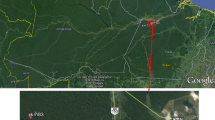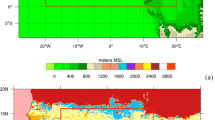Abstract
The fluxes of water and energy between the land surface and atmosphere involve many complex non-linear processes. In this study, the Noah and Noah-MP land surface models with multiple groundwater sub-models are used to assess how the treatment of canopy processes and interactions with deep groundwater affect 6 month regional climate simulations in two contrasting years, 2002 and 2010. Unlike the free drainage models, the models with groundwater capability have upward flux from the aquifer at different periods in the simulation. The inter-model Noah-MP soil moisture and latent heat flux results are consistent with recharge differences: the stronger upward flux capability with interactive groundwater results in the highest soil moisture and latent heat flux of the Noah-MP models. The increased latent heat effect on increased precipitation is small, which may result from negligible differences in convective precipitation. The Noah-MP model, independent of groundwater option, improves upon a cold and dry bias in the spring Noah simulations both during the day and night. The results for summer are region dependent and also differ between year and time of day. For a majority of the simulation period, there is little groundwater effect on the Noah-MP near-surface diagnostic fields. However, when the Noah-MP model produces large warm/dry biases in the 2010 summer, the aquifer interactions in Noah-MP improve the air temperature bias by 1–2 °C and dew point temperature bias by 1 °C.





Similar content being viewed by others
Explore related subjects
Discover the latest articles and news from researchers in related subjects, suggested using machine learning.References
Barthlott C, Kalthoff N (2011) A numerical sensitivity study on the impact of soil moisture on convection-related parameters and convective precipitation over complex terrain. J Atmo Sci 68:2971–2987
Brimelow J, Hanesiak J, Burrows W (2011) Impacts of land – atmosphere feedbacks on deep, moist convection on the Canadian prairies. Earth Interact 15:1–29
Chen F, Dudhia J (2001) Coupling an advanced land surface-hydrology model with the Penn State-NCAR MM5 modeling system. Part I: model implementation and sensitivity. Mon Weather Rev 129:569–585
Chen F et al (2007) Description and evaluation of the characteristics of the NCAR high-resolution land data assimilation system during IHOP-02. J Appl Meteorol Climatol 46:694–713
CPC (2013) CPC US Unified Precipitation data provided by the NOAA/OAR/ESRL PSD, Boulder, Colorado, USA, from their Web site at http://www.esrl.noaa.gov/psd/
Dirmeyer P et al (2012) Evidence for enhanced land-atmosphere feedback in a warming climate. J Hydrometeor 13:981–995
Ferguson IM, Maxwell RM (2010) Role of groundwater in watershed response and land surface feedbacks under climate change. Water Resour Res 46, W00F02. doi:10.1029/2009WR008616
Ferguson CR, Wood EF (2011) Observed land–atmosphere coupling from satellite remote sensing and reanalysis. J Hydrometeor 12:1221–1254
Findell K, Gentine P, Lintner B, Kerr C (2011) Probability of afternoon precipitation in eastern United States and Mexico enhanced by high evaporation. Nat Geosci 4:434–439
Jiang X, Niu G-Y, Yang Z-L (2009) Impacts of vegetation and groundwater dynamics on warm season precipitation over the Central United States. J Geophys Res 114, D06109. doi:10.1029/2008JD010756
Kollet SJ, Maxwell RM (2008) Capturing the influence of groundwater dynamics on land surface processes using an integrated, distributed watershed model. Water Resour Res 44, W02402. doi:10.1029/2007WR006004
Koster RD et al (2004) Regions of strong coupling between soil moisture and precipitation. Sci 305:1138–1140
Maxwell RM, Miller NL (2005) Development of a coupled land surface and groundwater model. J Hydrometeorol 6:233–247
Maxwell RM et al (2007) Development of a coupled groundwater – atmosphere model. Mon Weather Rev 139:96–116
Maxwell RM, Chow FK, Kollet SJ (2011) The groundwater land- surface-atmosphere connection: soil moisture effects on the atmospheric boundary layer in fully-coupled simulations. Adv Wat Resour 30:2447–2466
Mesinger, F., et al (2006) North American Regional Reanalysis. Bull. Amer. Meteor. Soc., 87:343–360.
Miguez-Macho G, Fan Y (2012) The role of groundwater in the Amazon water cycle: 2. Influence on seasonal soil moisture and evapotranspiration. J Geophys Res 117, D15114. doi:10.1029/2012JD017540
Miguez-Macho G, Fan Y, Weaver CP, Walko R, Robock A (2007) Incorporating water table dynamics in climate modeling: 2. Formulation, validation, and soil moisture simulation. J Geophys Res 112, D13108. doi:10.1029/2006JD008112
National Centers for Environmental Prediction (2004) NCEP ADP Global Surface Observational Weather Data, retrieved from http://rda.ucar.edu/datasets/ds461.0/
Niu G-Y et al (2011) The community Noah land surface model with multiparameterization options (Noah-MP): 1. Model description and evaluation with local-scale measurements. J Geophys Res 116, D12109. doi:10.1029/2010JD015139
Rasmussen R et al (2010) High-resolution coupled climate runoff simulations of seasonal snowfall over Colorado: a process study of current and warmer climate. J Clim 24:3015–3048
Schar C, Luthi D, Beyerle U (1999) The soil-precipitation feedback: a process study with a regional climate model. J Clim 12:722–741
Seuffert G, Gross P, Simmer C (2002) The influence of hydrologic modeling on the predicted local weather: Two-way coupling of a mesoscale weather prediction model and a land surface hydrologic model. J Hydrometeorol 3:505–523
Skamarock WC, Klemp JB, Dudhia J, Gill DO, Barker DM, Duda M, Huang X.-Y, Wang W, Powers JG (2008) A Description of the Advanced Research WRF Version 3, NCAR Technical Note, p 384
Trier S, Chen F, Manning K, LeMone MA, Davis C (2008) Sensitivity of the simulated PBL and precipitation to land surface conditions for a 12-Day warm-season convection period in the Central United State. Mon Weather Rev 136:2321–2343
Zaitchik B, Santanello J, Kumar S, Peters-Lidard C (2013) Representation of soil moisture feedbacks during drought in NASA Unified WRF. J Hydrometeor 14:360–367
Zeng X, Barlage M, Castro C, Fling K (2010) Comparison of land–precipitation coupling strength using observations and models. J Hydrometeor 11:979–994
Acknowledgments
Research support was provided through grants from the Joint Center for Satellite Data Assimilation (Grant no. NA13NES4400003) and National Oceanic and Atmospheric Administration (MAPP-CTB grant no. NA14OAR4310186).
Author information
Authors and Affiliations
Corresponding author
Additional information
This article is part of a Special Issue on “Regional Earth System Modeling” edited by Zong-Liang Yang and Congbin Fu.
Electronic supplementary material
Below is the link to the electronic supplementary material.
ESM 1
(DOCX 831 kb)
Rights and permissions
About this article
Cite this article
Barlage, M., Tewari, M., Chen, F. et al. The effect of groundwater interaction in North American regional climate simulations with WRF/Noah-MP. Climatic Change 129, 485–498 (2015). https://doi.org/10.1007/s10584-014-1308-8
Received:
Accepted:
Published:
Issue Date:
DOI: https://doi.org/10.1007/s10584-014-1308-8




